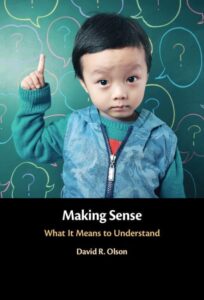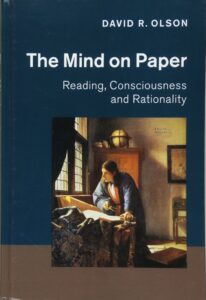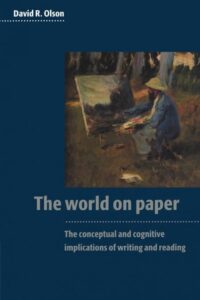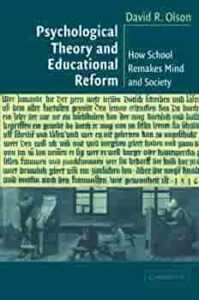Written by Faizan Rana
In this post, the OISE Library will highlight the work of OISE Professor Emeritus, Dr. David R. Olson in disseminating academic knowledge within his subject expertise. Throughout his career at OISE, Dr. Olson has played a pivotal role in developing the field of Educational Psychology, particularly within areas pertaining to children’s literacy. Additionally, Dr. Olson has served as the Director of the McLuhan Program in Culture and Technology from 1982-1990, where he advanced Literary Theory by discussing how cognitive understandings of text were derived from cultural evolutions. Later, in a 2009 interview, Dr. Olson commented on the cultural importance of digitizing materials citing its role in “democratized literacy” by linking communities.
 Recently, Dr. Olson has released his 20th book publication titled, Making Sense: What it Means to Understand. This book explores a primary branch in his research interests about how literacy progression in children affects their acquisition and development of understanding. Pursuing what he refers to as a “theory of mind”, this concept refers to how children become conscious that others’ views of the world differ from their own perspective. Fundamentally, Dr. Olson discusses how the languages children are taught affect their “theory of mind” & colour their perspectives and interpretations of the world. Fundamental to the “theory of mind” is the notion of “understanding.” This book aims to better elucidate the role of understanding which has been theorized as the primary faculty of the mind by philosophers and scholars, including Descartes, Locke, & Kant. Thus, this book aids in delving deeper into early childhood processes of understanding that have not been extensively examined in modern sciences.
Recently, Dr. Olson has released his 20th book publication titled, Making Sense: What it Means to Understand. This book explores a primary branch in his research interests about how literacy progression in children affects their acquisition and development of understanding. Pursuing what he refers to as a “theory of mind”, this concept refers to how children become conscious that others’ views of the world differ from their own perspective. Fundamentally, Dr. Olson discusses how the languages children are taught affect their “theory of mind” & colour their perspectives and interpretations of the world. Fundamental to the “theory of mind” is the notion of “understanding.” This book aims to better elucidate the role of understanding which has been theorized as the primary faculty of the mind by philosophers and scholars, including Descartes, Locke, & Kant. Thus, this book aids in delving deeper into early childhood processes of understanding that have not been extensively examined in modern sciences.
 Through his many years of scholarly research, Dr. Olson has maintained a strong reputation within areas of educational literacy. This is evident through his publishing a recent book in 2016, The Mind on Paper: Reading, Consciousness and Rationality, which posits how reading and writing function as “doorways” into our conscious representations of language that are less explicit, and consciously manifested in verbal speech. Dr. Olson discusses how this is vital in enabling human beings to make meta-representational concepts concrete in a systematized manner. Not only does this enable literacy to flourish, but also serves as a prerequisite to complex thought and rationality. In large part, these factors are what give literacy its value in society and why education is always a pivotal part of political debate. Additionally, this book provides insight into literacy from the perspective of cognitive sciences which has limited research. This book also explores theories relating both writing and mind such as Vygotsky’s theory of language as well as pedagogical & psychological aspects of reading. This book is an important contribution for educators, or scholars interested in literacy & developmental psychology.
Through his many years of scholarly research, Dr. Olson has maintained a strong reputation within areas of educational literacy. This is evident through his publishing a recent book in 2016, The Mind on Paper: Reading, Consciousness and Rationality, which posits how reading and writing function as “doorways” into our conscious representations of language that are less explicit, and consciously manifested in verbal speech. Dr. Olson discusses how this is vital in enabling human beings to make meta-representational concepts concrete in a systematized manner. Not only does this enable literacy to flourish, but also serves as a prerequisite to complex thought and rationality. In large part, these factors are what give literacy its value in society and why education is always a pivotal part of political debate. Additionally, this book provides insight into literacy from the perspective of cognitive sciences which has limited research. This book also explores theories relating both writing and mind such as Vygotsky’s theory of language as well as pedagogical & psychological aspects of reading. This book is an important contribution for educators, or scholars interested in literacy & developmental psychology.
 In the same vein, Dr. Olson earlier work, The World on Paper: The Conceptual and Cognitive Implications of Writing and Reading (1994), also focuses on how aspects of reading and writing have developmentally but also historically advanced to shape perceptions of language, the mind, & nature by consequence. Our understanding of the world is then in a way drawn from how we represent “the world on paper” as suggested by Dr. Olson who drew on contributions from various fields like linguistics, anthropology, & psychology within this book. Within this book, Olson begins by arguing against common assumptions that writing is merely a transcription of speech or that alphabetic language systems are better than syllabic alternatives. Once again, Olson draws on areas of psychology and anthropology from renowned theorists like Vygotsky & Cole to reinforce his stances. Olson then takes a historical approach to examining changes in writing practices from the Middle Ages to the Renaissance in regard to theological practices. Notable cultural shifts are also mentioned with the advent of the printing press making written books, maps, & paper credentials more commonplace which invariably impacted societal social dynamics. Near the end, Olson returns to his own research on children’s understanding of utterances. All in all, this book is great in providing context for historical influences on literacy development & modern influences educational literacy.
In the same vein, Dr. Olson earlier work, The World on Paper: The Conceptual and Cognitive Implications of Writing and Reading (1994), also focuses on how aspects of reading and writing have developmentally but also historically advanced to shape perceptions of language, the mind, & nature by consequence. Our understanding of the world is then in a way drawn from how we represent “the world on paper” as suggested by Dr. Olson who drew on contributions from various fields like linguistics, anthropology, & psychology within this book. Within this book, Olson begins by arguing against common assumptions that writing is merely a transcription of speech or that alphabetic language systems are better than syllabic alternatives. Once again, Olson draws on areas of psychology and anthropology from renowned theorists like Vygotsky & Cole to reinforce his stances. Olson then takes a historical approach to examining changes in writing practices from the Middle Ages to the Renaissance in regard to theological practices. Notable cultural shifts are also mentioned with the advent of the printing press making written books, maps, & paper credentials more commonplace which invariably impacted societal social dynamics. Near the end, Olson returns to his own research on children’s understanding of utterances. All in all, this book is great in providing context for historical influences on literacy development & modern influences educational literacy.
 In another earlier work, Psychology and Educational Reform (2003), Dr. Olson offers a critical examination of why schools remain rigid in spite of calls for reforms is provided via a theoretical psychology perspective. In this examination, Olson discusses how educational institutions shape the minds of their students & lay people. He mentions how schools are consistently able to do so by meeting both student body & bureaucratic societal performance expectations, thus reinforcing their institutional position. This somewhat parallels his most recent book on Making Sense… in how literacy shapes children’s theory of mind. Moreover, Dr. Olson mentions a tension between the needs of educational institutions (e.g., evaluation, teaching, and taxpayer responsibilities) and the needs of students (e.g., learning, goals, & ambition). Any educational reform would need to balance both “institutional” and “pedagogical” needs to succeed. This explains why Dewey’s late 1970s push for more collaborative rather than rote-memorization schooling was denied as it focused too heavily on solely children’s needs.
In another earlier work, Psychology and Educational Reform (2003), Dr. Olson offers a critical examination of why schools remain rigid in spite of calls for reforms is provided via a theoretical psychology perspective. In this examination, Olson discusses how educational institutions shape the minds of their students & lay people. He mentions how schools are consistently able to do so by meeting both student body & bureaucratic societal performance expectations, thus reinforcing their institutional position. This somewhat parallels his most recent book on Making Sense… in how literacy shapes children’s theory of mind. Moreover, Dr. Olson mentions a tension between the needs of educational institutions (e.g., evaluation, teaching, and taxpayer responsibilities) and the needs of students (e.g., learning, goals, & ambition). Any educational reform would need to balance both “institutional” and “pedagogical” needs to succeed. This explains why Dewey’s late 1970s push for more collaborative rather than rote-memorization schooling was denied as it focused too heavily on solely children’s needs.
All of these books written by Dr. Olson are available via the OISE Library collections either in physical or eBook formats.
